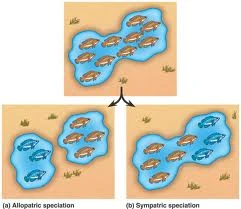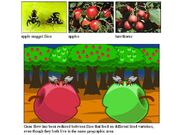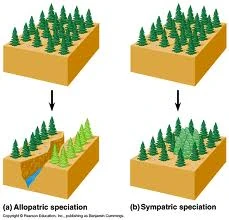
Sympatric Speciation
SoapBerry Beetle example of sympatric speciation
Sympatric speciation is when a new species evolved from a single ancestral species, while living in the same geographic region.
John Maynard Smith was one of the pioneer evolutionary biologists who, in 1966, modeled that sympatry could occur. Maynard Smith theorized that, under specific environmental conditions, an individual homozygous for a certain trait could have better fitness than an individual heterozygous for that trait. Natural selection will select for the homozygous individual over the heterozygous individual (Maynard Smith, 1966). Eventually, this could lead to speciation ( Dickinson and Antonovics confimed that sympatry is theoretically possible, provided that a) assortive mating is strong enough; and b) the combined strength of selective and assortive mating is large enough (Dickinson & Antonovics, 1973) Dickinson, H., & Antonovics, J. (1973). Theoretical considerations of sympatric divergence. American Naturalist, 256-274.Maynard Smith, J. (1966). Sympatric Speciation. American Naturalist. 100(916): 637-650.
Examples
Sypatric speciation may be more common than originally thought. One example is the soapberry beetle (shown in the "sympatric speciation video). The soapberry beetle feeds on native soapberry plants. The plant has a large fruit, and the beetle has a long beak (mouthpart) that allows them to eat from the large fruit. A non-native species of soapberry plant with a smaller fruit was introduced. The beetles with the long beak had difficulty eating these fruits. However, there were a few genetically different beetles that had a smaller beak, who did very well eating the smaller fruits of the non-native plant. With this new food source, the smaller beaked beetles thrived and the population grew (Carrol & Fox, 2007).

Allopatric and Sympatric speciation
Carroll, S. P., & Fox, C. W. (2007). Dissecting the evolutionary impacts of plant invasions: bugs and beetles as native guides. Global Change Biology, 13(8), 1644-1657.
Another Example
Another example of sympatric speciation are of the apple maggot flies. These flies only mated on hawthorn trees, but after apple trees were introduced into North America, they began to mate on the apple trees as well. Generally the apple maggot flies that generally mated on the hawthorn trees continued throughout generations, as well as the apple trees. Thus, sympatric speciation occurred and new species were formed.

Evolution 101, Sympatric Speciation. [1]

Allopatric and Sympatric speciation
Cichlid fish in Lake Victoria may serve as yet an example of sympatric speciation. Over the course of the past 15,000, an estimated over 500 different species of cichlid have evolved in Lake Victoria--equivalent to a new species developing every 30 years (Berkeley, 2009; Spinney, 2010). Recent research by Ole Seehausen and colleagues suggests that natural and sexual selection may have played a key role in the speciation of cichlids in Lake Victoria. “In two related species the females choose mates based on their coloration. In one, found in deeper parts of the lake, the males have red features. In the other, found in shallower waters, the males are blue” (Fountain, 2008, p. D3). Since the water of Lake Victoria is cloudy with organic matter, as depths increase, blue light waves are gradually filtered, giving way to a more red-based spectrum. Thus, Seehausen projects that the original spilt between the two species may have been a result of adaptations in the visual system to meet these different light environments; adaptations that were then subsequently reinforced through sexual selection (Fountain, 2008).
University of California, Berkeley (2009, March). Sex, speciation, and fishy physics. Retrieved from: http://evolution.berkeley.edu/evolibrary/news/090301_cichlidspeciation
Fountain, H. (2008, October 2). Seeing red and blue can divide a species of fish. The New York Times, p. D3. Retrieved from: http://www.nytimes.com/2008/10/07/science/07obfish.html?ref=science&_r=0
Seehausen, O., van Alphen, J. J. M. & Witte, F. (1997). Cichlid fish diversity threatened by eutrophication that curbs sexual selection Science, 277, 1808-1811.
Spinney, L. (2010). Evolution: Dreampond revisited. Nature, 466, 174-175. Retrieved from: http://www.nature.com/news/2010/100707/full/466174a.html